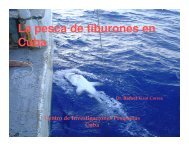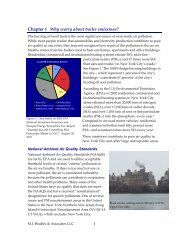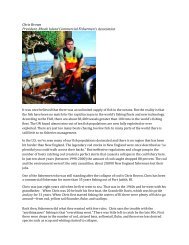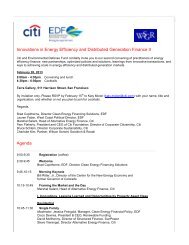the Maritimes of Canada. Three studies are presented for fisheries along the easternseaboard of the United States, though that for red snapper describes a fishery in whichthe actual implementation of the programme was thwarted by the imposition of themoratorium on Individual Transferable Quotas (ITQs). An omnibus account is givenfor the allocation process of quotas in New Zealand. In the Western Pacific, accountsare given for the Pacific halibut and sablefish fisheries in Alaska, the variety of fisheriesin British Columbia including these last two species.162. Sigler, M., Lunsford, C., 2001. Effects of individual quotas on catching efficiency and spawningpotential in the Alaska sablefish fishery. Can. J. Fish. Aquat. Sci./J. can. sci. halieut. aquat.58(7): 1300-1312. Individual fishery quota (IFQ) management eliminates the race forfish and may improve economic efficiency, conservation, and safety in fisheries.Empirical information documenting these effects is limited, even though IFQs havebeen used since the late 1970s. We analyzed fishery data from the Alaska sablefish(Anoplopoma fimbria) longline fishery, which came under IFQ management in 1995. Wecompared the fishery data with fishery-independent survey data, which acted as acontrol to separate annual changes in population demographics from changes due toIFQ management. We found that IFQ management increased fishery catch rate anddecreased harvest of immature fish. Catching efficiency increased 1.8 times with thechange from an open-access to an IFQ fishery. The improved catching efficiency of theIFQ fishery reduced variable costs to catch the quota from 8 to 5% of landed value, asavings averaging $3.1 million US annually. Decreased harvest of immature fishimproved the chance that individual fish will reproduce at least once. Spawningpotential of sablefish, expressed as spawning biomass per recruit, increased 9% for theIFQ fishery. Switching from the open-access fishery’s race for fish to IFQs providedtwo clear benefits that should be considered when evaluating management options forother open-access fisheries.163. South Atlantic Fishery Management Council (SAFMC), 2006a. Fishery Management Plansfor 1) Coastal Migratory Pelagics, 2) Dolphin/Wahoo, 3) Golden Crab, 4) Shrimp, 5) SnapperGrouper, and 6) Spiny Lobster. Retrieved March 14, 2006, fromhttp://www.safmc.net/Default.aspx?tabid=395. Current and historical fisherymanagement plans for specified fisheries.164. South Atlantic Fishery Management Council (SAFMC), 2006b. South Atlantic SnapperGrouper Fishery Management Plan Amendment 13C. September. FMP for SA snappergrouper.165. Southwick Associate and Loftus, A., 2006. Menhaden Math: The Economic Impact ofAtlantic Menhaden on Virginia’s Recreational and Commercial Fisheries. American SportfishingAssociation. http://www.menhadenmatter.org/menhaden_math.pdf. Atlanticmenhaden are a vital source of food for many fish species, serving as a critical link inthe food chain on which a number of highly important commercial and recreationalsaltwater fisheries, such as striped bass, bluefish and weakfish, depend. This report,conducted by Southwick Associates and Loftus Consulting, examines the importance ofa healthy and well managed menhaden stock to Virginia’s commercial and recreationalfisheries. Among its findings: 1) Nearly 1 million saltwater anglers cast their luck inVirginia waters each year, spending more than $655 million for marine sportfishing- 28 -
activity. The economic value of the menhaden reduction fishery in Virginia is beingeclipsed by the recreational fishery for species that rely on menhaden as a food source.2) Of the fish that saltwater anglers most like to catch – the majority depend onmenhaden for survival. According to research conducted at the Virginia Institute ofMarine Sciences for the Virginia Marine Resources Commission, striped bass, whichrely on menhaden as a prime food source, were the sportfish most targeted by saltwateranglers. 3) According to data from the Virginia Institute of Marine Science,approximately 30 percent of the economic benefits that marine recreational anglingprovides to Virginia is due to sportfish dependent on menhaden as a food source. 4)Saltwater angling for fish that rely on menhaden as a key part of their diet generates2,500 full and part-time jobs and $236 million in overall economic activity.5)Commercial menhaden landings generated approximately $24 million for the Virginiaeconomy and about 395 full time jobs.166. Standing Senate Committee on Fisheries, 1998. Privatization and Quota Licensing inCanada's Fisheries. Third Report, December 1998.http://www.parl.gc.ca/36/1/parlbus/commbus/senate/com-e/fish-e/repe/rep03dec98part1-e.htm.Data on number of crew in the BC sablefish fishery. Generalreport discusses privatization issues in Canada’s fisheries.167. Straker, G., Kerr, S., Hendy, J. 2002. A Regulatory History of New Zealand’s QuotaManagement System: setting targets, defining and allocating quota. Paper presented at IIFET2002: Fisheries in the Global Economy, International Fisheries Economic Conferencein Wellington, New Zealand. http://www.motu.org.nz/pdf/IIFET_Fish_paper.pdf. Inthis paper we define the regulatory structure of the New Zealand Quota ManagementSystem (QMS) and document key changes in its operation over time. We document therelevant legislation that affected the quota market from the Fisheries Act 1983 forward.We describe how the QMS operates in New Zealand and how the regulations haveevolved and changed to address specific issues as they come to light. We discuss thesetting of aggregate targets and the definition of quota and summarize the process ofallocating quota to fishers in New Zealand. This paper is part of a larger project thatwill also discuss market structure issues such as rules regulating quota trades,concentration of holdings, foreign ownership of quota, 'banking' provisions, andfunding. The paper either directly describes the legislation or, for more detail, providesreferences to key resources. This will provide researchers with a reference document onthe New Zealand fisheries regulatory structure as a basis for future empirical work. Theversion of the paper presented here is an abridged version. A full version of theworking paper is available at: http://www.motu.org.nz/nz_fish.htm. This project wasfunded by the New Zealand Ministry of Fisheries and Resources for the Future.168. Sullivan, K.J.; Mace, P.M.; Smith, N.W.McL.; Griffiths, M.H.; Todd, P.R.; Livingston,M.E.; Harley, S.J.; Key, J.M. and Connell, A.M. (Comps.) 2005: Report from the FisheryAssessment Plenary, May 2005: stock assessments and yield estimates. 792 p. (Unpublishedreport held in NIWA library, Wellington.)http://www.fish.govt.nz/sustainability/research/assessment/plenary/orh3B.pdf. Stockassessment of New Zealand Orange Roughy for 2005, including historical biomass,catch, and TAC. Orange roughy are found in waters deeper than 750 m throughout- 29 -
- Page 4 and 5: fishery, which is regulated by 2-mo
- Page 6 and 7: 30. Clark, W., St-Pierre, G., 1997.
- Page 8 and 9: eleas/2001/nr024_e.htm. Description
- Page 10 and 11: 61. Gislason, GS, 2002. BC Seafood
- Page 12 and 13: 72. Hall-Arber, M. et al. 2004. New
- Page 14 and 15: Description of the 2005 IPHC regula
- Page 16 and 17: 94. Maryland Commercial Fisheries,
- Page 18 and 19: uyer broker, an increased competiti
- Page 20 and 21: http://www.fakr.noaa.gov/ram/daily/
- Page 22 and 23: Harvest by Port e.g. http://www.fak
- Page 24 and 25: 133. Pacific Fishery Management Cou
- Page 26 and 27: September. The paper focused on DAP
- Page 30 and 31: Quota Management Area 3B. Historica
- Page 32: 1995, the program changed its empha


![Annotated bibliography [PDF] - Environmental Defense Fund](https://img.yumpu.com/50613332/29/500x640/annotated-bibliography-pdf-environmental-defense-fund.jpg)

![What do we mean by MSY? [PDF]](https://img.yumpu.com/49525661/1/190x245/what-do-we-mean-by-msy-pdf.jpg?quality=85)

![Print version [PDF] - Environmental Defense Fund](https://img.yumpu.com/46812189/1/190x201/print-version-pdf-environmental-defense-fund.jpg?quality=85)
![Mercury Alert: Cleaning up Coal Plants for Healthier Lives [PDF]](https://img.yumpu.com/45587786/1/190x143/mercury-alert-cleaning-up-coal-plants-for-healthier-lives-pdf.jpg?quality=85)


![Program Overview [PDF] - Environmental Defense Fund](https://img.yumpu.com/34005758/1/190x96/program-overview-pdf-environmental-defense-fund.jpg?quality=85)


